Abstract
With the progress of society and the development of science and technology, the development of transportation is particularly important. Therefore, the road-rail bridge has rapidly developed. We searched the relevant literature from 2002 to 2022 in the Web of Science database in order to objectively understand the research status and development trend of road-rail bridges. We use bibliometric analysis methods to analyze the year of publication, number of publications, distribution of academic journals, research institutions, application fields, analysis theories, test methods and influencing factors in the field of road-rail bridges. Using Citespace software, we analyzed 184 research articles related to road-rail bridges.
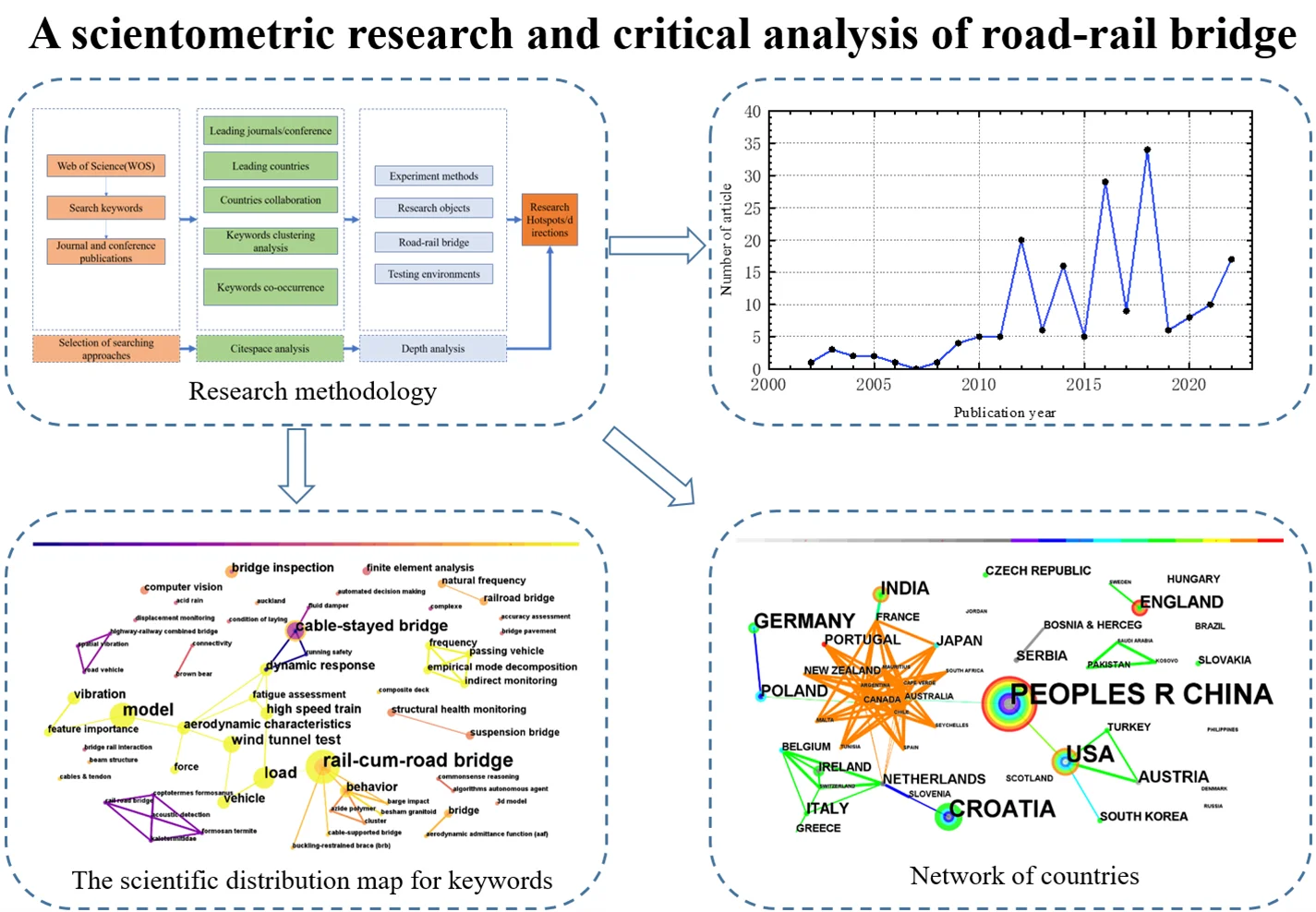
Highlights
- Analysis of the trend topics revealed that the following keywords are the most active research directions in the field of road-rail bridges: rail-cum-road bridge, model, wind tunnel test, load, vibration, aerodynamic characteristics, dynamic response and cable-stayed bridge.
- Experimental technology and numerical simulation have become the most widely used research methods in the field of road-rail bridges, especially wind tunnel tests.
- In the field of road-rail bridges, most of the research was focused on structural engineering, especially structural aerodynamic characteristics, which is the most critical research content, followed by construction methods.
1. Introduction
This paper will comprehensively review the scientific literature related to road-rail bridges using scientometric research methods. Scientometric research has been widely used in various scientific fields, including geohazard research [1], safety science [2], intelligent disaster management [3], microalgae-based wastewater treatment [4], recycled aggregate concrete [5], green buildings [6], and BIM (building information model) [7]. By consulting the academic journals related to road-rail bridges from 2002 to 2022 in the Web of Science (WOS) database, we used Citespace to conduct an in-depth analysis on the trend of road-rail bridges [8]. We aim to identify the research focus and development direction in the road-rail bridges field and to provide a detailed analysis of road-rail bridge research for researchers in this field. Our review is divided into the following sections, Section 2 presents our research methodology, Section 3 analyzes the keywords identified by Citespace, and Section 4 discusses the experimental methods used in the study of road-rail bridges. Section 5 deduces the research content of the road-rail bridge according to the research object and technology. The final section summarizes the results of our analysis and provides a comprehensive overview of the current state of research on road-rail bridges.
2. Research methodology
We used the Web of Science (WOS) database in this paper due to its reliability and academic journals with a wide range of impact. Since there are many academic publications on road-rail bridges, it is very important for our research to consult and analyze relevant literature. To ensure the quality and rapid visualization of the literature, we have set the search conditions to English-language conferences and journals. This paper analyzes the road-rail bridge research status based on the publications derived from WOS by the software Citespace. Furthermore, the research frame of this paper is as Fig. 1.
Fig. 1Research approach for road-rail bridge
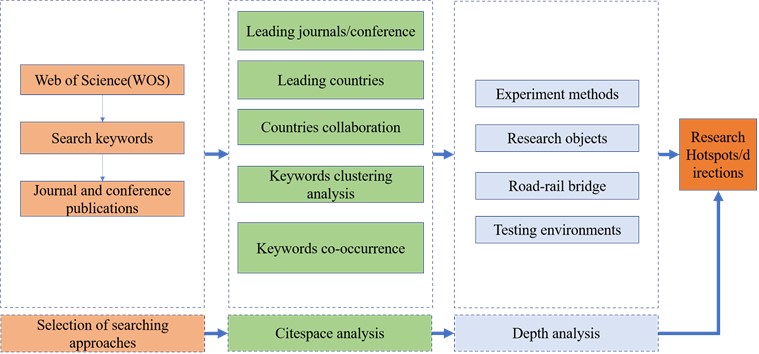
3. Scientometric analysis
3.1. Publication trends by year
Exactly 184 academic publications on road-rail bridges are evaluated. Fig. 2 depicts a graphical overview of the yearly publication pattern of relevant articles from 2002 to 2022, including journal publications and conference proceedings. From 2002 to 2011, fewer relevant articles were published, and this period can be characterized as an evolving period. Since 2012, the research on the road-rail bridge has been overgrowing. Especially in the three years of 2012, 2016 and 2018, due to the convening of the Road and Rail Infrastructure, a large number of relevant articles were published. Overall, research interest continues to grow.
Fig. 2Number of academic publications in road-rail bridge from 2003 to 2022.
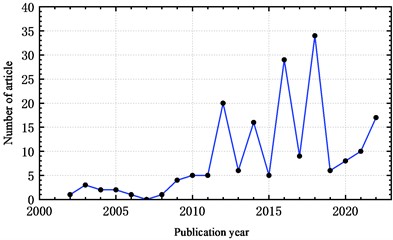
3.2. Top journals and conference proceedings
The top journals and conference proceedings can help beginners quickly understand their domain research. Table 1 shows the conference proceedings and leading journals on the road-rail bridge area. Our analysis shows that publications related to road-rail bridge research are mostly focused on the structure, vibration, and control system of these bridges. Furthermore, the top three journals are Engineering Structures, J Bridge Eng, and J Sound Vib. The top three conference proceedings are the 5th International Conference on Road and Rail Infrastructure Cetrasoftware (EMSOFT 2011), the 2ND International Conference on Road and Rail Infrastructure Cetra, and the 4th International Conference on Road and Rail Infrastructure Cetra.
Table 1Journals and conference proceedings publications in road-rail bridge from 2002 to 2022: a) Journals publications, b) Conference proceedings publications.
a) Journals publications | ||
Journal title | Frequency of cited | Total publications |
Engineering Structures | 36 | 19.57 % |
J Bridge Eng | 16 | 8.70 % |
J Sound Vib | 16 | 8.70 % |
Struct Infrastruct E | 15 | 8.15 % |
Adv Struct Eng | 14 | 7.61 % |
J Wind Eng Ind Aerod | 13 | 7.07 % |
b) Conference proceedings publications | ||
Conference title | Number of article | Total publications |
5th International Conference on Road and Rail Infrastructure Cetrasoftware (Emsoft 2011) | 23 | 12.50 % |
2nd International Conference on Road and Rail Infrastructure Cetra | 17 | 9.24 % |
4th International Conference on Road and Rail Infrastructure Cetra | 15 | 8.15 % |
3rd International Conference on Road and Rail Infrastructure Cetra | 9 | 4.89 % |
6th Transport Research Arena Tra | 6 | 3.26 % |
3.3. Analysis of keywords
Keywords can abstractly and effectively reflect core research content. Scholars can identify the core research content and future research trends in a specific field by analyzing keywords. to gain a more accurate and comprehensive understanding of the trends in research and critical points and development about road-rail bridges, we performed a keyword analysis, which is presented in Fig. 3.
Fig. 3The scientific distribution map for keywords
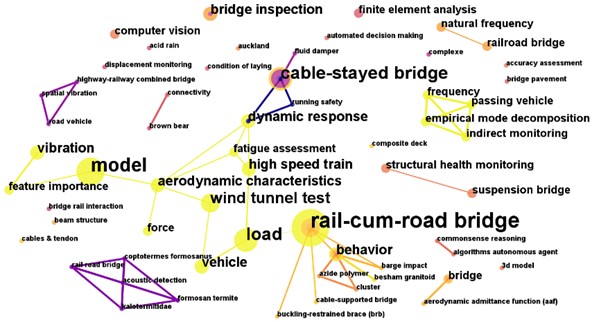
Some keywords with the same semantics are grouped together. the trivial and universality words are ignored. in the figure, the larger the dot represents, the more occurrences and the more representative of the hotspots in the field, and the nodes are connected to represent the strength of association, and the more lines represent the more occurrences of two keywords in the same article. Through Fig. 3, we can see that rail-cum-road bridge, model, wind tunnel test, load, vibration, aerodynamic characteristics, dynamic response, cable-stayed bridge, etc., are the representative high-frequency keywords in this field.
In Citespace, cluster naming is determined based on nominal terms extracted from cited publications, which can be considered an indication of future research trends. The documents that form the co-citation matrix and the clustering of keywords can reflect the research frontier. Consequently, we determine the research frontiers in the field of road-rail bridges by studying the clustering of keywords. The different colours in the cluster analysis represent the clustering of topics, as shown in Fig. 4.
It can be found that keywords are clustered into seven categories: rail-cum-road bridge, road-rail same-story truss bridge, thermal response, environmental influence, cable-stayed bridge, aerodynamic admittance function and dimer. the number of keywords decreases from clustering #0 to clustering #7, indicating that road-rail same-story truss bridge covers a broader range of research topics.
Fig. 4Keywords clustering analysis
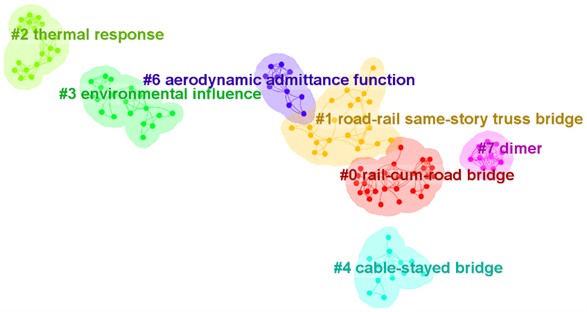
3.4. Network of countries
To understand which countries have made outstanding contributions to the field of road-rail bridges, we analyzed data from all 35 countries using Citespace. Fig. 5 shows the linkages and density of countries based on citations, respectively. The circle size represents a country's contribution to the subject of study, and the connection indicates that the two countries have cooperative relations. as shown in Fig. 5, China (52 articles), Croatia (24 articles), USA (22 articles), Germany (14 articles), India (10 articles) and England (9 articles) have made important contributions to the publications in this research.
Fig. 5Network of countries
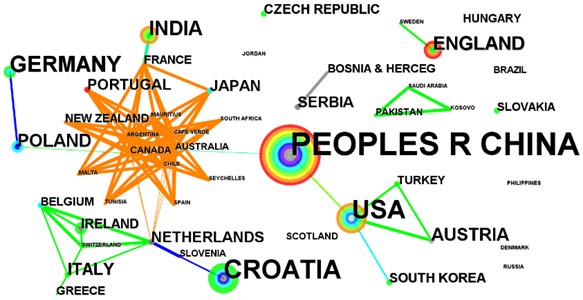
4. Research methods for road-rail bridge
Research methods for road-rail bridges are given in Table 2. Experimental technology is the most widely used research method, including field and model tests. The wind tunnel test is the most widely used model test method, widely used in the study of wind-induced aerodynamic characteristics of road-rail bridges. in addition, static loading tests and shaking table tests are also used. Non-Destructive Testing, one of the field test methods, is widely used in the structural health monitoring research of the road-rail bridge. Through experimental technology, it is ensured that the road-rail bridge can safely and reliably bear the expected load and environmental impact in actual use.
Table 2Research methods for road-rail bridge
Research methods | Number of article | Total articles |
Experimental technology | 44 | 23.91 % |
Numerical simulation | 36 | 19.57 % |
Data analysis | 29 | 15.76 % |
Theoretical analysis | 17 | 9.24 % |
Field test | 9 | 4.89 % |
The numerical simulation method establishes the finite element model with Ansys, Midas and other software to carry out static, dynamic, and seismic simulations. in order to predict the seismic performance and aerodynamic characteristics of the road-rail bridge and provide data help for the design and construction optimization. Data analysis and theoretical analysis are widely used in road-rail bridges' strength, stability and reliability analysis. Several recent papers have adopted various research methods, especially the combination of experimental technology and numerical simulation. Using experiments to verify the accuracy of numerical simulation, and using numerical simulation to reveal the microscopic mechanism of experimental phenomena, has become a popular research method [9-12].
5. Research contents of road-rail bridge
The study of road-rail bridges encompasses various topics, including design, construction, operation, maintenance, and safety. Some key research fields in the field of road-rail bridges are shown in Table 3.
Table 3Research contents of road-rail bridge
Research contents | Number of article | Total articles |
Structural engineering | 61 | 33.15 % |
Construction methods | 38 | 20.65 % |
Performance evaluation | 29 | 15.76 % |
Operation and maintenance | 12 | 6.52 % |
Environmental impact | 9 | 4.89 % |
The most studied is structural engineering. This research area focuses on the development of innovative and efficient designs for road-rail bridges. Key considerations include load capacity, dynamic effects, and vibration-related studies such as structural resistance to earthquakes and wind. the second is construction methods. This research area focuses on the development of new construction methods and materials for road-rail bridges. Key considerations include cost-effectiveness, sustainability, and safety. The third is performance evaluation. This research area focuses on the assessment of the performance of road-rail bridges, including their structural integrity, load capacity, and durability. Key considerations include the impact of environmental factors, such as temperature and humidity, on bridge performance. Overall, the study of road-rail bridges is an important area of research with implications for transportation infrastructure, safety, and environmental sustainability. Using scientometric analysis, we can better understand the research trends and gaps in this field, which can inform future research and development efforts.
6. Conclusions
With the development of society, higher requirements have been put forward for transportation, especially with the development of urban rail transit technology. the road-rail bridge has become a hot topic. the research on road-rail bridges has exhibited an upward trend in the number of articles in recent years, and this comprehensive bibliometric research provided an overview of 184 articles published between 2002 and 2022.
1) Analysis of the trend topics revealed that the following keywords are the most active research directions: rail-cum-road bridge, model, wind tunnel test, load, vibration, aerodynamic characteristics, dynamic response and cable-stayed bridge.
2) Experimental technology and numerical simulation have become the most widely used research methods, especially wind tunnel tests. The combination of experiments and numerical simulation has become a hot research method.
3) Most of the research was focused on structural engineering, especially structural aerodynamic characteristics, which is the most critical research content, followed by construction methods.
It is evident through this research that road-rail bridges are an essential infrastructure of modern societies, and further research into the field is needed to ensure these bridges’ safe and efficient operation.
References
-
S. Jiang, J. Ma, Z. Liu, and H. Guo, “Scientometric Analysis of artificial intelligence (AI) for geohazard research,” Sensors, Vol. 22, No. 20, p. 7814, Oct. 2022, https://doi.org/10.3390/s22207814
-
J. Li, F. Goerlandt, and G. Reniers, “An overview of scientometric mapping for the safety science community: Methods, tools, and framework,” Safety Science, Vol. 134, p. 105093, Feb. 2021, https://doi.org/10.1016/j.ssci.2020.105093
-
S. Neelam and S. K. Sood, “A scientometric review of global research on smart disaster management,” IEEE Transactions on Engineering Management, Vol. 68, No. 1, pp. 317–329, Feb. 2021, https://doi.org/10.1109/tem.2020.2972288
-
Z. Li and L. Zhu, “The scientometric analysis of the research on microalgae-based wastewater treatment,” Environmental Science and Pollution Research, Vol. 28, No. 20, pp. 25339–25348, May 2021, https://doi.org/10.1007/s11356-021-12348-4
-
B. Zhang, W. Ahmad, A. Ahmad, F. Aslam, and P. Joyklad, “A scientometric analysis approach to analyze the present research on recycled aggregate concrete,” Journal of Building Engineering, Vol. 46, p. 103679, Apr. 2022, https://doi.org/10.1016/j.jobe.2021.103679
-
I. Y. Wuni, G. Q. P. Shen, and R. Osei-Kyei, “Scientometric review of global research trends on green buildings in construction journals from 1992 to 2018,” Energy and Buildings, Vol. 190, pp. 69–85, May 2019, https://doi.org/10.1016/j.enbuild.2019.02.010
-
X. Zhao, “A scientometric review of global bim research: Analysis and visualization,” Automation in Construction, Vol. 80, pp. 37–47, Aug. 2017, https://doi.org/10.1016/j.autcon.2017.04.002
-
F. Yang, D. Shi, Q. Mao, and K.-H. Lam, “Scientometric research and critical analysis of battery state-of-charge estimation,” Journal of Energy Storage, Vol. 58, p. 106283, Feb. 2023, https://doi.org/10.1016/j.est.2022.106283
-
D. Damjanović, I. Duvnjak, M. Bartolac, and J. Košćak, “Operational modal analysis of two identical single span road bridges,” in Fifth International Conference on Road and Rail Infrastructure, pp. 103–110, May 2018, https://doi.org/10.5592/co/cetra.2018.901
-
S. Oh, S.-I. Seo, H. Lee, and H.-E. Lee, “Prediction of Wind Velocity to Raise Vortex-Induced Vibration through a Road-Rail Bridge with Truss-Shaped Girder,” Shock and Vibration, Vol. 2018, pp. 1–10, Aug. 2018, https://doi.org/10.1155/2018/2829640
-
L.-L. Liu, Y.-F. Zou, X.-H. He, Z. Wang, and X.-H. Zhou, “Effects of wind barriers on the aerodynamic characteristics of bridge-train system for a road-rail same-story truss bridge,” Journal of Central South University, Vol. 29, No. 8, pp. 2690–2705, Aug. 2022, https://doi.org/10.1007/s11771-022-5103-9
-
G. Yao, Y. Chen, Y. Yang, Y. Zheng, H. Du, and L. Wu, “Investigation of vortex-induced vibration of double-deck truss girder with aerodynamic mitigation measures,” Journal of Marine Science and Engineering, Vol. 11, No. 6, p. 1118, May 2023, https://doi.org/10.3390/jmse11061118
About this article
This research was supported by the Chongqing City Infrastructure Construction Investment Co., Ltd. [grant number CQCT-JSA-GC-2021-0140] and National Key Research and Development Program of China (2021YFC3100300).
The datasets generated during and/or analyzed during the current study are available from the corresponding author on reasonable request.
The authors declare that they have no conflict of interest.
